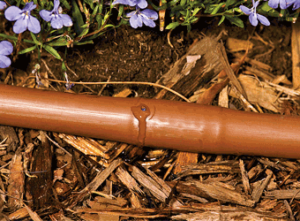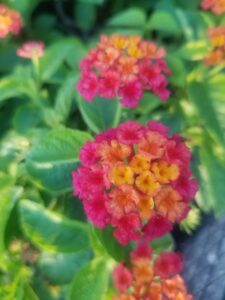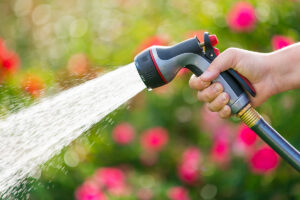By: Anna Stubbendick, FCHP
At Canterbury Farms Nursery & Garden Center, we’ve been receiving many calls from concerned customers about brown leaves and dying plants. Unfortunately, the lack of rain over the past several months has left many landscapes struggling to survive. We understand how frustrating it can be to see your hard work in the garden go to waste, but there are steps you can take to help your plants and trees survive during a drought.
Be Proactive
In Florida, April and May are typically the driest months of the year, which means that there is very little relief in sight for the near future. As we move into the warmer season, it’s important to take steps to care for your landscape during a drought. With less rain and higher temperatures, your plants and trees may struggle to thrive without the proper attention. Here are some tips for taking care of your landscape during a drought:
-

Drip irrigation helps conserve water and deliver the water directly to the roots of the plants where it’s needed most.
Water wisely: It’s important to water your plants and trees deeply and as infrequently as possible during a drought. Watering deeply means to apply water slowly and thoroughly to the soil, allowing it to penetrate deeply into the roots of the plant. This encourages the roots to grow deeper into the soil, where they can access moisture more easily, making them more resilient during dry spells. To water deeply, it’s best to use a soaker hose or drip irrigation system. These methods allow the water to be delivered slowly and directly to the soil, rather than spraying water on the leaves of the plant or creating runoff. It’s important to water at a slow enough rate that the water has time to penetrate deeply into the soil. In general, you should aim to water to a depth of about 6 inches for most plants. However, the exact amount of water required will depend on the type of soil, the size of the plant, and the weather conditions. You can use a soil moisture meter or simply check the soil with your fingers to determine when it’s time to water again. Remember that over-watering can be just as harmful as under-watering, so it’s important to strike a balance and water your plants only when they need it. Avoid watering during the hottest part of the day when the water is more likely to evaporate.
- Mulch your plants: Adding a layer of mulch around your plants and trees can help to retain moisture in the soil. Mulch also helps to regulate soil temperature, keeping roots cool during hot weather. Use a natural mulch like pine straw or bark chips to create a 2-3 inch layer around your plants.
-

Lantana is a great Florida-Friendly Landscaping plant that is available in a wide range of colors. However most Lantana carried at Canterbury Farms is not one of the native species. ©Photo by Anna Stubbendick, Canterbury Farms
Choose drought-tolerant plants: If you’re planning to add new plants to your landscape, choose varieties that are well-suited to dry conditions. Native plants like Gaillardia, Lantana, and Beach Sunflower are good choices for Florida gardens. These plants are adapted to survive periods of drought and will require less water than other varieties. The UF/IFAS Extension’s list of Florida-Friendly Landscaping plants is an excellent resource for plant selection, as water conservation is one of the nine principles of Florida-Friendly Landscaping.
- Prune your trees: Pruning your trees during a drought can help to reduce the amount of water they need. Remove any dead or damaged branches, as these can sap moisture from the rest of the tree. Prune branches that are crossing or rubbing against each other, as this can create wounds that are vulnerable to pests and disease.
- Adjust your lawn care routine: Lawns require a lot of water to stay green during a drought, so it’s important to adjust your lawn care routine accordingly. Raise your mower blade to the highest setting recommended for your turf grass variety to leave the grass longer, which will help to shade the soil and reduce moisture loss. Only water your lawn when it begins to show signs of stress, such as wilting or browning.
It’s important to remember that during a drought, plants and trees may not show symptoms of stress until it’s too late. By the time leaves turn brown or drop from the tree, it may already be too late to save it. That’s why it’s important to take proactive measures to care for your landscape during a drought, such as the ones mentioned above.
What can I do if my plants are already looking bad?
If your plants are already showing signs of stress from lack of water, it’s important to act quickly to help them recover. Here are some additional steps you can take to revive stressed plants:
- Prune damaged leaves and branches: If your plants have leaves or branches that are wilted or brown, prune them off. This will help the plant conserve energy and focus on new growth.
- Provide shade: If your plants are in an area that receives full sun, consider providing some shade to help them recover from drought stress. You can use a shade cloth or even an umbrella to provide temporary shade.
- Fertilize: Once your plants have started to recover, you may want to consider fertilizing them with a slow-release fertilizer to encourage new growth. Be sure to follow the instructions on the fertilizer carefully and don’t over-fertilize, as this can damage your plants.
What should I do if my community has watering restrictions?
If your community watering restrictions do not allow for enough water to keep your plants thriving during a drought, there are several steps you can take to help your plants survive:
-

In most communities, hand-watering is allowed in spite of any watering restrictions that may be in place. ©Photo by Adobe Stock
Prioritize your watering: If you can only water certain areas of your landscape, prioritize your watering based on the needs of your plants. Focus on watering plants that are most susceptible to drought stress, such as newly planted trees and shrubs, vegetable gardens, and plants that are already showing signs of stress.
- Use gray water: If it is legal in your area, consider using gray water from your washing machine or shower to water your plants. Gray water is water that has been used in the home, but is not contaminated with sewage. Be sure to use eco-friendly soaps and detergents that won’t harm your plants.
- Use drought-tolerant plants: Consider replacing water-thirsty plants with drought-tolerant species that require less water. Many native plants are adapted to local climate conditions and are naturally drought-tolerant.
- Use shade cloth or other covers: Using shade cloth or other covers can help to protect your plants from the hot sun and reduce water loss through evaporation.
- Consider hand-watering: If watering restrictions are severe, consider hand-watering your plants using a watering can or hose with a spray nozzle. This will allow you to direct water exactly where it’s needed, without wasting any. Even in communities with strict watering regulations, there are usually no restrictions on hand-watering. If you’re not sure, please check your local guidelines.
If you’re unsure about the health of your plants or trees, don’t hesitate to contact us at Canterbury Farms Nursery & Garden Center. Our experienced staff can provide advice on how to care for your landscape during a drought and help you identify any issues that may be affecting your plants.
Remember, prevention is key when it comes to caring for your landscape during a drought. By following the tips mentioned above and staying proactive about your plant care routine, you can help your plants and trees survive and thrive during even the driest months of the year.
